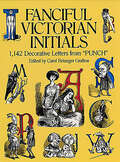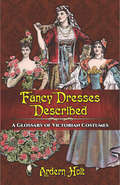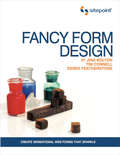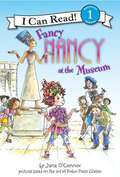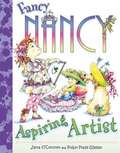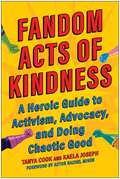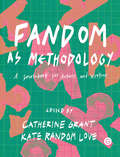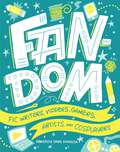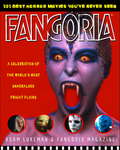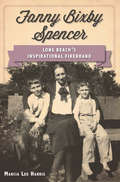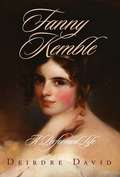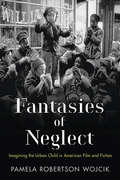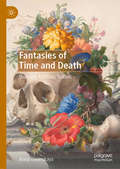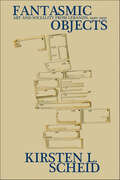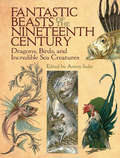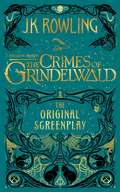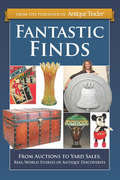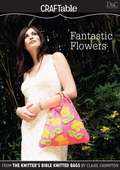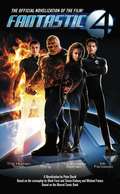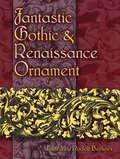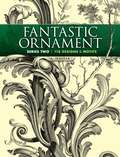- Table View
- List View
Fanciful Victorian Initials: 1,142 Decorative Letters from "Punch" (Dover Pictorial Archive)
by Carol Belanger GraftonRich compendium of capital letters selected from venerable British humor magazine. Astonishing wit, invention, draughtsmanship in letters drawn by Tenniel, Leech, Sambourne, Doyle, other Victorian masters. Historic calligraphy; topical, political, literary allusions; animals, plants, many other motifs. All copyright-free. Inexhaustible graphic inspiration.
Fancy Dresses Described: A Glossary of Victorian Costumes
by Ardern HoltThe Victorians adored fancy-dress parties: what better way to escape the rigidity of social conventions than to spend a festive evening disguised as Cleopatra, a Swiss milkmaid, or Alice in Wonderland? Well-to-do party-goers of the era consulted Fancy Dresses Described, an elaborate guide to hundreds of glorious costumes. The book was so popular that it was updated several times; this is the sixth and final edition, originally published in 1896. Time has transformed it into an important historical document as well as an abundant cosplay resource. Twenty color and 40 black-and-white illustrations enhance the alphabetical entries, which are mostly for women's costumes but include a section on children's dress. Costumes range from the peasant garb of Austria, Italy, and Ireland to the finery of the six wives of Henry VIII, Marie Antoinette, and other members of French and English royalty. Additional entries spotlight characters from Shakespeare and Dickens; traditional apparel of Egypt and ancient Greece and Rome; Cinderella, Maid Marian, and other folkloric figures; as well as outfits suggested by astronomy, the seasons, the animal kingdom, and other thematic subjects. Costume designers, reenactors, lovers of Victorian fashion, and Halloween enthusiasts will find this historic volume a tremendous source of inspiration.
Fancy Form Design: Create Sensational Web Forms That Sparkle (Sitepoint Ser.)
by Jina Bolton Derek Featherstone Tim ConnellForms' - is there any other word that strikes as much fear into the hearts of web designers? Not any more ...Fancy Form Design is a practical hands-on, full color book that follows the process of creating visually stunning yet usable web forms, from start to end. The book covers all design elements from planning the form's purpose and interface through to mastering markup, applying style with CSS, and adding interactivity and visual effects with JavaScript. By the end of the you'll will have the code, and wisdom, they need to build fancy forms of their own.
Fancy Nancy at the Museum (I Can Read! #Level 1)
by Jane O'ConnorNancy's class is going on a trip to the museum, and Nancy wants to be extra fancy for the occasion. After a bumpy bus ride, she doesn't feel very well. Luckily for Nancy, her teacher, Ms. Glass, has a few fancy tricks of her own. Nothing can keep Nancy from making this trip magnifique! (That's a fancy French word for great!)
Fancy Nancy: Aspiring Artist (I Can Read!)
by Jane O'ConnorIt's spring vacation and Fancy Nancy is feeling glum because her best friend Bree, is out of town. Luckily, it's Nancy's mom to the rescue! She brings home a brand new set of glitter markers. Nancy puts her trademark flair to tres creative use and devotes herself to becoming a serious artist (or artiste, as the French say). After all, everything about being an aspiring artist is fancy, fancy, fancy--especially when inspiration strikes!
Fandom Acts of Kindness: A Heroic Guide to Activism, Advocacy, and Doing Chaotic Good
by Tanya Cook Kaela JosephFandom can save the world! This first of its kind, actionable and inspirational resource provides the tools and motivation necessary for pop culture fans to make a difference—while having fun! Fandoms are united as a community because of the power of story. And it&’s exactly the magical alchemy forged when mixing story and community that has helped fandoms across the world feed thousands of hungry children, donate countless books, build schools, register voters, disrupt online hate speech, and save lives through crafting PPE for COVID-19 frontline workers, natural disaster response, and mental health crisis support. Fandom Acts of Kindness not only tells the stories of the good fans have done in the world but serves as a dungeon master&’s guide to how to be a hero yourself. Perfect for those who want to inspire others, organize collective action, sustain, and nurture your own mental health and creativity, and do it all through a pop culture perspective.
Fandom as Methodology: A Sourcebook for Artists and Writers (Goldsmiths Press Ser.)
by Catherine Grant Kate Random LoveAn illustrated exploration of fandom that combines academic essays with artist pages and experimental texts.Fandom as Methodology examines fandom as a set of practices for approaching and writing about art. The collection includes experimental texts, autobiography, fiction, and new academic perspectives on fandom in and as art. Key to the idea of “fandom as methodology” is a focus on the potential for fandom in art to create oppositional spaces, communities, and practices, particularly from queer perspectives, but also through transnational, feminist and artist-of-color fandoms. The book provides a range of examples of artists and writers working in this vein, as well as academic essays that explore the ways in which fandom can be theorized as a methodology for art practice and art history. Fandom as Methodology proposes that many artists and art writers already draw on affective strategies found in fandom. With the current focus in many areas of art history, art writing, and performance studies around affective engagement with artworks and imaginative potentials, fandom is a key methodology that has yet to be explored. Interwoven into the academic essays are lavishly designed artist pages in which artists offer an introduction to their use of fandom as methodology.ContributorsTaylor J. Acosta, Catherine Grant, Dominic Johnson, Kate Random Love, Maud Lavin, Owen G. Parry, Alice Butler, SooJin Lee, Jenny Lin, Judy Batalion, Ika Willis.Artists featured in the artist pages Jeremy Deller, Ego Ahaiwe Sowinski, Anna Bunting-Branch, Maria Fusco, Cathy Lomax, Kamau Amu Patton, Holly Pester, Dawn Mellor, Michelle Williams Gamaker, The Women of Colour Index Reading Group, Liv Wynter, Zhiyuan Yang
Fandom: Fic Writers, Vidders, Gamers, Artists, and Cosplayers
by Francesca Davis DiPiazzaHave you ever finished a book or TV series and wished for more? Created stories, art, or videos based on a game? Dressed up as your favorite character? If so, you've entered fandom. Fan writers expand and mix up stories, like sending the Star Trek crew to Hogwarts. Cosplayers sew Star Wars and Sailor Moon costumes, and fan filmmakers make music video tributes. Fans also enrich invented worlds with greater diversity, creating female and multiracial avatars for games peopled only with white male characters. Tour fandom's history and meet fan writers, video-makers, artists, costumers, and gamers who celebrate the things they love and shape fan communities online and in real life.
Fangoria's 101 Best Horror Movies You've Never Seen
by Adam LukemanA FEAST OF FRIGHTFUL FLICKS WAITING TO BE REDISCOVEREDAs the leading name in the world of horror, Fangoria magazine has been the source of information for fans of fright flicks for more than twenty years--covering feature films, video games, comic books, collectibles, and all aspects of horror entertainment. Working closely with Fangoria's experts, including Editor in Chief Anthony Timpone, Adam Lukeman has compiled a must-have guide for casual horror fans and hardcore horror junkies with Fangoria's 101 Best Horror Films You've Never Seen. With a brief synopsis for each of the included films, lists of cast and crew, "Terror Trivia," and little-known facts about these lesser-known but must-see gems, Fangoria's 101 Best Horror Films You've Never Seen offers a feast of gruesome information. Featured here are flicks that were dumped by their distributors or were initially flops, like Cherry Falls, Manhunter, and Pumpkinhead, foreign winners such as Cronos, The Vanishing, and Funny Games, and straight-to-video sleepers waiting to be discovered, including Shadowbuilder, Jack Be Nimble, and Nomads. There are even surprise entries directed by industry giants--movies like George A. Romero's Day of the Dead, Brian De Palma's Sisters, or Dario Argento's Opera--that are frequently overshadowed by the filmmakers' other, better-known works but are worthy of further examination. Entertaining and informative, Fangoria's 101 Best Horror Movies You've Never Seen offers more than a hundred reasons to look beyond the often ho-hum Hollywood hype fests . . . when you're really in the mood to feel your flesh crawl.From the Trade Paperback edition.
Fanny Bixby Spencer: Long Beach's Inspirational Firebrand
by Marcia Lee HarrisThe last daughter born to Jotham Bixby, the "Father of Long Beach," Fanny Bixby Spencer (1879-1930) carved her own singular and eccentric path across California history. Born to wealth and power, she chose a boldly independent, egalitarian lifestyle in an age when women's lives were largely confined to domesticity. Fanny served with the Long Beach Police Department as America's first policewoman. She was a founder of the city of Costa Mesa in Orange County. Her humanitarian efforts reached across ethnicities and social standing. Yet beyond her civic accomplishments, Fanny was provocative as a poet, artist, pacifist, suffragist, child advocate, foster mother and humanitarian. Marcia Lee Harris captures this fascinating woman's remarkable life, enhanced by Fanny's own poetry and soulful reflections.
Fanny Kemble
by Deirdre DavidA ForeWord magazine Book of the Year for 2007Charismatic, highly intelligent, and splendidly talented, Fanny Kemble (1809-93) was a Victorian celebrity, known on both sides of the Atlantic as an actress and member of the famous Kemble theatrical dynasty, as a fierce opponent of slavery despite her marriage to a wealthy slave owner, as a brilliantly successful solo performer of Shakespeare, and as the author of journals about her career and life on her husband's Georgia plantations. She was, in her own words, irresistible as a "woman who has sat at dinner alongside Byron . . . and who calls Tennyson, Alfred."Touring in America with her father in the early 1830s, Kemble impulsively wed the wealthy and charming Philadelphia bachelor Pierce Butler, beginning a tumultuous marriage that ended in a sensational divorce and custody battle fourteen years later. At the time of their marriage, Kemble had not yet visited the vast Georgia rice and cotton plantations to which Butler was heir. In the winter of 1838, they visited Butler's southern holdings, and a horrified Kemble wrote what would later be published on both sides of the Atlantic as Journal of a Residence on a Georgian Plantation. An important text for abolitionists, it revealed the inner workings of a plantation and the appalling conditions in which slaves lived. Returning to England after her divorce, she fashioned a new career as a solo performer of Shakespeare's plays and as the author of memoirs, several travel narratives and collections of poems, a short novel, and miscellaneous essays on the theater. For the rest of her life, she would divide her time between the two countries.In the various roles she performed in her life, on stage and off--abolitionist, author, estranged wife--Kemble remained highly theatrical, appropriating and subverting nineteenth-century prescriptions for women's lives, ever rewriting the roles to which she was assigned by society and inheritance. Hers was truly a performed life, and in the first Kemble biography in twenty-five years to examine that life in its entirety, Deirdre David presents it in all its richness and complexity.
Fantasia of Color in Early Cinema (Framing Film)
by Joshua Yumibe Tom Gunning Jonathon Rosen Giovanna FossatiWe normally think of early film as being black and white, but the first color cinematography appeared as early as the first decade of the twentieth century. In this visually stunning book, the editors present a treasure trove of early color film images from the archives of EYE Film Institute Netherlands, bringing to life their rich hues and forgotten splendor., Carefully selecting and reproducing frames from movies made before World War I, Fossati, Gunning, Rosen, and Yumibe share the images here in a full range of tones and colors. Accompanying essays discuss the history of early film and the technical processes that filmmakers employed to capture these fascinating images, while other contributions explore preservation techniques and describe the visual delights that early film has offered audiences, then and now. Featuring more than 300 color illustrations for readers to examine and enjoy, Fantasia of Color in Early Cinema will engage scholars and other readers of all ages and backgrounds.
Fantasies of Neglect
by Pamela Robertson WojcikIn our current era of helicopter parenting and stranger danger, an unaccompanied child wandering through the city might commonly be viewed as a victim of abuse and neglect. However, from the early twentieth century to the present day, countless books and films have portrayed the solitary exploration of urban spaces as a source of empowerment and delight for children. Fantasies of Neglect explains how this trope of the self-sufficient, mobile urban child originated and considers why it persists, even as it goes against the grain of social reality. Drawing from a wide range of films, children's books, adult novels, and sociological texts, Pamela Robertson Wojcik investigates how cities have simultaneously been demonized as dangerous spaces unfit for children and romanticized as wondrous playgrounds that foster a kid's independence and imagination. Charting the development of free-range urban child characters from Little Orphan Annie to Harriet the Spy to Hugo Cabret, and from Shirley Temple to the Dead End Kids, she considers the ongoing dialogue between these fictional representations and shifting discourses on the freedom and neglect of children. While tracking the general concerns Americans have expressed regarding the abstract figure of the child, the book also examines the varied attitudes toward specific types of urban children--girls and boys, blacks and whites, rich kids and poor ones, loners and neighborhood gangs. Through this diverse selection of sources, Fantasies of Neglect presents a nuanced chronicle of how notions of American urbanism and American childhood have grown up together.
Fantasies of Neglect: Imagining the Urban Child in American Film and Fiction
by Pamela Robertson WojcikIn our current era of helicopter parenting and stranger danger, an unaccompanied child wandering through the city might commonly be viewed as a victim of abuse and neglect. However, from the early twentieth century to the present day, countless books and films have portrayed the solitary exploration of urban spaces as a source of empowerment and delight for children. Fantasies of Neglect explains how this trope of the self-sufficient, mobile urban child originated and considers why it persists, even as it goes against the grain of social reality. Drawing from a wide range of films, children's books, adult novels, and sociological texts, Pamela Robertson Wojcik investigates how cities have simultaneously been demonized as dangerous spaces unfit for children and romanticized as wondrous playgrounds that foster a kid's independence and imagination. Charting the development of free-range urban child characters from Little Orphan Annie to Harriet the Spy to Hugo Cabret, and from Shirley Temple to the Dead End Kids, she considers the ongoing dialogue between these fictional representations and shifting discourses on the freedom and neglect of children. While tracking the general concerns Americans have expressed regarding the abstract figure of the child, the book also examines the varied attitudes toward specific types of urban children--girls and boys, blacks and whites, rich kids and poor ones, loners and neighborhood gangs. Through this diverse selection of sources, Fantasies of Neglect presents a nuanced chronicle of how notions of American urbanism and American childhood have grown up together.
Fantasies of Precision: American Modern Art, 1908-1947
by Ashley LazevnickRedefining the artistic movement that helped shape American modernism In the early decades of the twentieth century, a loose contingent of artists working in and around New York City gave rise to the aesthetic movement known as precisionism, primarily remembered for its exacting depictions of skyscrapers, factories, machine parts, and other symbols of a burgeoning modernity. Although often regarded as a singular group, these artists were remarkably varied in their subject matter and stylistic traits. Fantasies of Precision excavates the surprising ties that connected them, exploring notions of precision across philosophy, technology, medicine, and many other fields. Bookended by discussions of the landmark First Biennial Exhibition of Painting at the Whitney Museum in 1932, this study weaves together a series of interconnected chapters illuminating the careers of Charles Sheeler, Georgia O&’Keeffe, and Charles Demuth. Built on a theoretical framework of the writing of modernist poets Marianne Moore and William Carlos Williams, Fantasies of Precision outlines an &“ethos of precision&” that runs through the diverse practices of these artists, articulating how the broad range of enigmatic imagery they produced was underpinned by shared strategies of restraint, humility, and slowness. Questioning straightforward modes of art historical classification, Ashley Lazevnick redefines the concept that designated the precisionist movement. Through its cross-disciplinary approach and unique blend of historiography and fantasy, Fantasies of Precision offers a comprehensive reevaluation of one of the defining movements of artistic modernism.
Fantasies of Time and Death: Dunsany, Eddison, Tolkien
by Anna VaninskayaThis book reveals the unique contribution made by the three founding fathers of British fantasy—Lord Dunsany, E. R. Eddison and J. R. R. Tolkien—to our culture’s perennial reassessment of the meanings of time, death and eternity. It traces the poetic, philosophical and theological roots of the striking preoccupation with mortality and temporality that defines the imagined worlds of early fantasy fiction, and gives both the form of such fiction and its ideas the attention they deserve. Dunsany, Eddison and Tolkien raise some of the oldest questions in existence: about the limits of nature, human and divine; cosmic creation and destruction; the immortality conferred by art and memory; and the paradoxes and uncertainties generated by the universal experience of transience, the fear of annihilation and the desire for transcendence. But they respond to those questions by means of thought experiments that have no precedent in modern literary history.
Fantasies of the Master Race: Literature, Cinema and the Colonization of American Indians
by Ward Churchill M. Annette JaimesIn this volume of incisive essays, Ward Churchill looks at representations of American Indians in literature and film, delineating a history of cultural propaganda that has served to support the continued colonization of Native America. During each phase of the genocide of American Indians, the media has played a critical role in creating easily digestible stereotypes of Indians for popular consumption. Literature about Indians was first written and published in order to provoke and sanctify warfare against them. Later, the focus changed to enlisting public support for "civilizing the savages," stripping them of their culture and assimilating them into the dominant society. Now, in the final stages of cultural genocide, it is the appropriation and stereotyping of Native culture that establishes control over knowledge and truth.
Fantasmic Objects: Art and Sociality from Lebanon, 1920–1950 (Public Cultures Of The Middle East And North Africa Ser.)
by Kirsten L. ScheidIn Lebanon, the study of modern art—rather than power or hierarchy—has compelled citizens to confront how they define themselves as a postcolonial nation.In Fantasmic Objects, Kirsten L. Scheid offers a striking study of both modern art in Lebanon and modern Lebanon through art. By focusing on the careers of Moustapha Farrouk and Omar Onsi, forefathers of an iconic national repertoire, and their rebellious student Saloua Raouda Choucair, founder of an antirepresentational, participatory art, Scheid traces an emerging sense of what it means to be Lebanese through the evolution of new exhibition, pedagogical, and art-writing practices. She reveals that art and artists helped found the nation during French occupation, as the formal qualities and international exhibitions of nudes and landscapes in the 1930s crystallized notions of modern masculinity, patriotic femininity, non-sectarian religiosity, and citizenship. Examining the efforts of painters, sculptors, and activists in Lebanon who fiercely upheld aesthetic development and battled for new forms of political being, Fantasmic Objects offers an insightful approach to the history and formation of modern Lebanon.
Fantastic Beasts of the Nineteenth Century: Dragons, Birds, and Incredible Sea Creatures (Dover Fine Art, History of Art)
by Anton SederFanciful creatures slither, swim, and soar through this full-color adaptation of a rare 19th-century German portfolio. The colorful images include exotic birds and fishes, dramatic reptiles and amphibians, and scores of ferocious dragons. This new layout of a hard-to-find antique volume presents enlargements of the original illustrations that offer magnified details of stylized feathers, fins, scales, and other fantastic features. The tremendous variety of these images makes this volume a perfect resource for all manner of graphics and art reference. This meticulously reproduced collection of fanciful creatures represents the first republication of Anton Seder's bestiary since the original 1896 edition. The Munich-based painter is best known for Die Pflanze in Kunst und Gewerbe (The Plant in Art and Trade), which incorporated plants into decorative patterns, and Das Thier in Der Decorativen Kunst (Animals in Decorative Art), which similarly integrated animals and mythical dragons into ornamental motifs. Designers, artists, and crafters will appreciate Seder's imaginative works and their distinctive combination of outstanding designs with keen observations of nature.
Fantastic Beasts: The Crimes of Grindelwald - The Original Screenplay (Harry Potter)
by J. K. Rowling Mina Lima<p>J.K. Rowling's five-film Fantastic Beasts adventure series continues with the original screenplay for Fantastic Beasts: The Crimes of Grindelwald. <p>At the end of Fantastic Beasts and Where to Find Them, the powerful Dark wizard Gellert Grindelwald was captured in New York with the help of Newt Scamander. But, making good on his threat, Grindelwald escapes custody and sets about gathering followers, most unsuspecting of his true agenda: to raise pure-blood wizards up to rule over all non-magical beings. <p>In an effort to thwart Grindelwald's plans, Albus Dumbledore enlists Newt, his former Hogwarts student, who agrees to help once again, unaware of the dangers that lie ahead. Lines are drawn as love and loyalty are tested, even among the truest friends and family, in an increasingly divided wizarding world. <p>This second original screenplay from J.K. Rowling, illustrated with stunning line art from MinaLima, expands on earlier events that helped shape the wizarding world, with some surprising nods to the Harry Potter stories that will delight fans of both the books and films.</p>
Fantastic Finds
by Eric BradleyFantastic Finds is an engaging and entertaining collection of real-world stories of people who discover gold amongst the unwanted. You'll read how a $700 auction gamble turns into a $38,500 sapphire bracelet or how one intrepid seeker found two rare carnival glass bowls in one day. Of course, some of the tales are sentimental journeys, where found pieces prove to be touching and priceless. Big or small, prized or priceless, Fantastic Finds tells the tales that make us all yearn for the hunt. And the reward.
Fantastic Flowers
by Claire CromptonThis is a great bag for a hot summer's day. The vivid colours zing against each other, and the sewed-on leaves add a pleasing three-dimensional touch. The stylish flare shape is created by decreasing the sides and bamboo rings are attached for added impact. Knitted in ever-versatile cotton yarn, this bag is robust enough to take on the beach, and smart and sassy enough to take to summer garden parties.
Fantastic Four: Official novelization of the new film
by Peter DavidScientific genius Dr. Reed Richards' lifelong dream is close to being realized--a trip to space and to the center of a cosmic storm to unlock the secrets of the human genetic code. Financed by rival-turned-billionaire-industrialist Victor Von Doom, Reed's crew for the mission includes his best friend, astronaut Ben Grimm; Susan Storm, Von Doom's director of genetic research and Reed's ex-girlfriend; and Sue's hot-headed younger brother, pilot Johnny Storm. With benefactor Von Doom in tow, the four set off for the exploration of a lifetime. But something goes terribly wrong, as cosmic radiation irrevocably alters their DNA and their future. Back on Earth, the effects of the exposure are quickly revealed: Reed gains the ability to stretch and contort his body into any shape he can imagine. Sue is able to render herself invisible and to create and project powerful force fields. Johnny can now engulf his body in flames and take flight at will, and Ben, whose freakish transmutation is the most shocking, becomes an orange-colored, rock-like, superhumanly strong creature. Together, they turn tragedy into triumph and catastrophe into coalition, and must use their unique and formidable powers against Victor Von Doom--who has also not escaped the effects of the cosmic storm unscathed. Adventurers. Super Heroes. Celebrities. To the world, they are the Fantastic Four. To each other, they are a family.
Fantastic Gothic and Renaissance Ornament
by Rudolf BerlinerAn Archive of Spectacular ImagesSpotlighting Pivotal Designs in the History of Western ArtDancing beasts of myth and legend, thick foliage that appears to live and breathe, reclining figures engulfed by symbols of fate--this magnificent compendium of 15th- and 18th-century embellishments offers up a dizzying array of Gothic and Renaissance designs steeped in religion and fantasy. A marvel of art history, 127 exquisitely rendered black-and-white illustrations will thrill students and art aficionados, and serve as a rich source of inspiration for anyone working in the fine or applied arts.
Fantastic Ornament, Series Two: 118 Designs and Motifs (Dover Pictorial Archive)
by A. HauserEngraved in the 19th century, these flamboyant ornamental designs are based on a wide variety of historical examples, dating back as far as the 1500s and including images by Watteau and Dürer. Created as embellishments for walls, arms and armor, and everyday objects, these designs remain eminently useful for graphic and decorative purposes.
